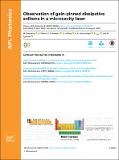Files in this item
Observation of gain-pinned dissipative solitons in a microcavity laser
Item metadata
| dc.contributor.author | Pieczarka, M. | |
| dc.contributor.author | Poletti, D. | |
| dc.contributor.author | Schneider, C. | |
| dc.contributor.author | Höfling, S. | |
| dc.contributor.author | Ostrovskaya, E. A. | |
| dc.contributor.author | Sek, G. | |
| dc.contributor.author | Syperek, M. | |
| dc.date.accessioned | 2020-08-17T08:30:02Z | |
| dc.date.available | 2020-08-17T08:30:02Z | |
| dc.date.issued | 2020-08-04 | |
| dc.identifier | 269644976 | |
| dc.identifier | 4770f542-8d17-47f4-b86a-ed22c659f671 | |
| dc.identifier | 000555441900001 | |
| dc.identifier | 85089875804 | |
| dc.identifier.citation | Pieczarka , M , Poletti , D , Schneider , C , Höfling , S , Ostrovskaya , E A , Sek , G & Syperek , M 2020 , ' Observation of gain-pinned dissipative solitons in a microcavity laser ' , APL Photonics , vol. 5 , no. 8 , 086103 . https://doi.org/10.1063/5.0010633 | en |
| dc.identifier.issn | 2378-0967 | |
| dc.identifier.uri | https://hdl.handle.net/10023/20475 | |
| dc.description | This work was supported by the National Science Center in Poland, by Grant Nos. 2016/23/N/ST3/01350 and 2018/30/E/ST7/00648, and by the Polish National Agency for Academic Exchange. The Würzburg group gratefully acknowledges support by the State of Bavaria. The work at the Australian National University was supported by the Australian Research Council. | en |
| dc.description.abstract | We demonstrate an experimental approach for creating spatially localized states in a semiconductor microcavity laser. In particular, we shape the spatial gain profile of a quasi-one-dimensional microcavity laser with a nonresonant, pulsed optical pump to create spatially localized structures, known as gain-pinned dissipative solitons, that exist due to the balance of gain and nonlinear losses. We directly probe the ultrafast formation dynamics and decay of these localized structures, showing that they are created on a picosecond timescale, orders of magnitude faster than laser cavity solitons. All of the experimentally observed features and dynamics are reconstructed by numerical modeling using a complex Ginzburg-Landau model, which explicitly takes into account the carrier density dynamics in the semiconductor. | |
| dc.format.extent | 8 | |
| dc.format.extent | 2374991 | |
| dc.language.iso | eng | |
| dc.relation.ispartof | APL Photonics | en |
| dc.subject | QC Physics | en |
| dc.subject | NDAS | en |
| dc.subject.lcc | QC | en |
| dc.title | Observation of gain-pinned dissipative solitons in a microcavity laser | en |
| dc.type | Journal article | en |
| dc.contributor.institution | University of St Andrews. Condensed Matter Physics | en |
| dc.contributor.institution | University of St Andrews. School of Physics and Astronomy | en |
| dc.identifier.doi | https://doi.org/10.1063/5.0010633 | |
| dc.description.status | Peer reviewed | en |
This item appears in the following Collection(s)
Items in the St Andrews Research Repository are protected by copyright, with all rights reserved, unless otherwise indicated.

